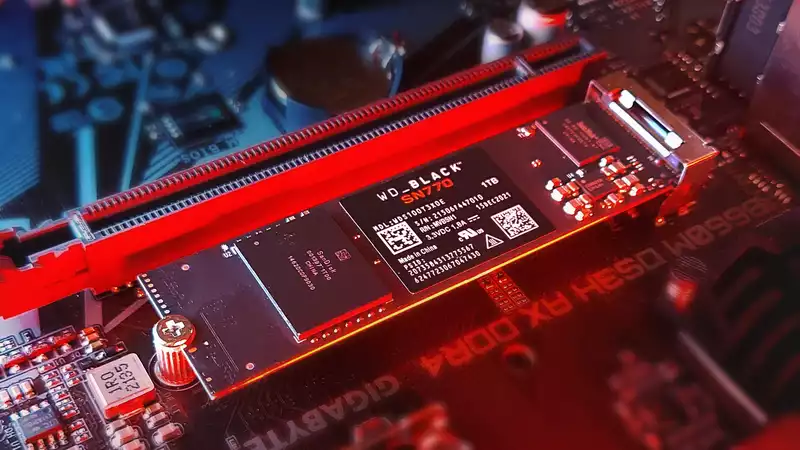Incredible NVMe SSD drives have been released recently, from the blazing speed of Kingston Renegade to the affordable Crucial P5 Plus. The latest drive to hit the market comes from the same camp as our favorite PCIe 4.0 SSD, the WD_Black SN850, but as its name suggests, it is not aiming for the top spot. The new WD_Black SN770 is intended to be a bit more of a value proposition compared to its faster sibling.
The main way it accomplishes this is by being a DRAM-less SSD drive. This allows manufacturers to significantly reduce component costs and, thanks to the latest controller advances, has a surprisingly small impact on performance. Don't get me wrong, such drives are slow, but even so, this new SN770 delivers 5,150 MB/s read and 4,900 MB/s write. Not bad.
As you can infer from these numbers, this means we are looking at a PCIe 4.0 SSD; nothing prevents you from inserting it into a PCIe 3.0 slot to maximize bandwidth, but that would limit peak throughput to about 3,500MB/s.
The drive itself is thin, and this 1TB model boasts a single NAND flash module on the back (actually a rebranded Kioxia BiCS5 112-Layer TLC chip) and a SanDisk controller located towards the connector. Western Digital doesn't reveal much about its controllers, and this is no different; the SN770 comes in four sizes (250GB, 500GB, 1TB, and 2TB), but the lack of a 4TB option is a bit disappointing.
Other than a large sticker in the center of the drive, this is all there is to it. There is nothing of note on the back of the drive. Given the amount of unused space here, one can't help but wonder if Western Digital could make a version of this drive that would fit on a Steam Deck; in the 2230 form factor, there are certainly few options for such a drive. But anyway...
The first thing to do with a new SSD is to fill it up to get a feel for what its performance will be like after it has actually been used, as opposed to its factory-perfect state. This also provides an opportunity to see at what point the dynamically allocated SLC cache will run out.
On this 1TB drive, the 2GB/sec transfer is about 130GB and then drops to just 400MB/sec. For reference, the Crucial P5 plus was capable of transferring 300GB until it reached the limit of its cache.
When looking at the performance of this drive, it is worth keeping in mind the price, which can be almost double the asking price of this drive. For comparison, we've included the $105 Western Digital SN770 1TB, a similarly budget-minded $135 Crucial P5 Plus 1TB, a DRAM-less $100 Samsung 980 1TB (PCIe 3.0 SSD), and the recently attractive price drop of the $150 compared to the $150 WD_Black SN850.
In the composite performance recorded by ATTO and AS SSD, the SN770 trails the Crucial P5 in reads, but is much closer in writes. However, the 4K performance is relatively impressive, indicating that the SN770 has something to offer in this crowded market. After all, being a PCIe 3.0 drive, it is not too surprising that this drive outperforms Samsung's DRAM-less offerings, but the degree to which it does is impressive.
It is worth noting that, like the SN850, this drive also gets hot when the drive is pushed. In our longer tests, we recorded a temperature of 76°C, but this was with direct cooling without the use of a heatsink. This should not be a problem in most systems, especially if the motherboard comes with a cooling solution.
However, it was in real-world testing that the SN770 really showed its power, with little difference from the Crucial P5 Plus. In fact, it would be difficult to tell the difference between the two in daily operations, and this is very important given the lower cost of this drive right now. If you need better performance, the SN850 is clearly the better drive, but it costs considerably more.
This is the story of the WD_Black SN770: the WD_BlackSN770 is not the fastest drive, nor is it the cheapest drive (although it is close). If you are on a budget but want to enjoy the high-speed performance of PCIe 4.0, there is a lot to like about this drive. It's certainly close to first-generation PCIe 4.0 performance, but if you're looking for more speed, you'll need to invest quite a bit more money.
It wasn't that long ago that the very idea of a DRAM-less NVMe SSD was looked upon with disdain. The Samsung 980 was dismissed by many before the results were even available, even though it didn't perform that badly for a PCIe 3.0 SSD. However, the SN770 looks to improve the DRAM-less situation, and these numbers are well deserved; Phison is also working on a PCIe 4.0 DRAM-less controller, and we expect to see such a drive soon.
DRAM-less drives are important simply because they are cheap; affordability is key to SSDs becoming more popular with a wider audience, and this is a good way to get close to, if not below, the $100 barrier for 1TB drives.
DirectStorage is expected to bring significant improvements to gaming, so the more gamers have fast drives in their machines, the more attractive it will be for developers to actually use them. It will certainly be a long road, perhaps years, before developers start pushing SSDs in earnest, but it's still good to plan ahead.
The only problem here is that the speed of the drives needed for DirectStorage is not clearly known. We know that some developers are targeting 5,000 MB/sec, and the SN770 is right where our tests put it. Therefore, the SN770 should perform well enough, and at this price, this performance is very attractive. However, if you are a serious gamer, we would recommend a slightly higher-end product, the WD_Black SN850.
.

Comments